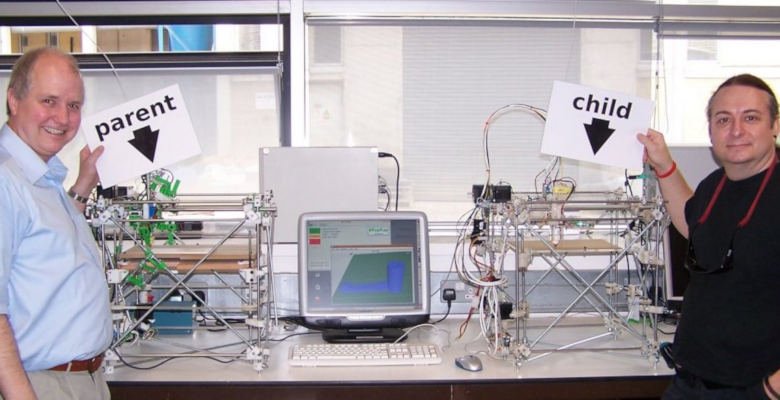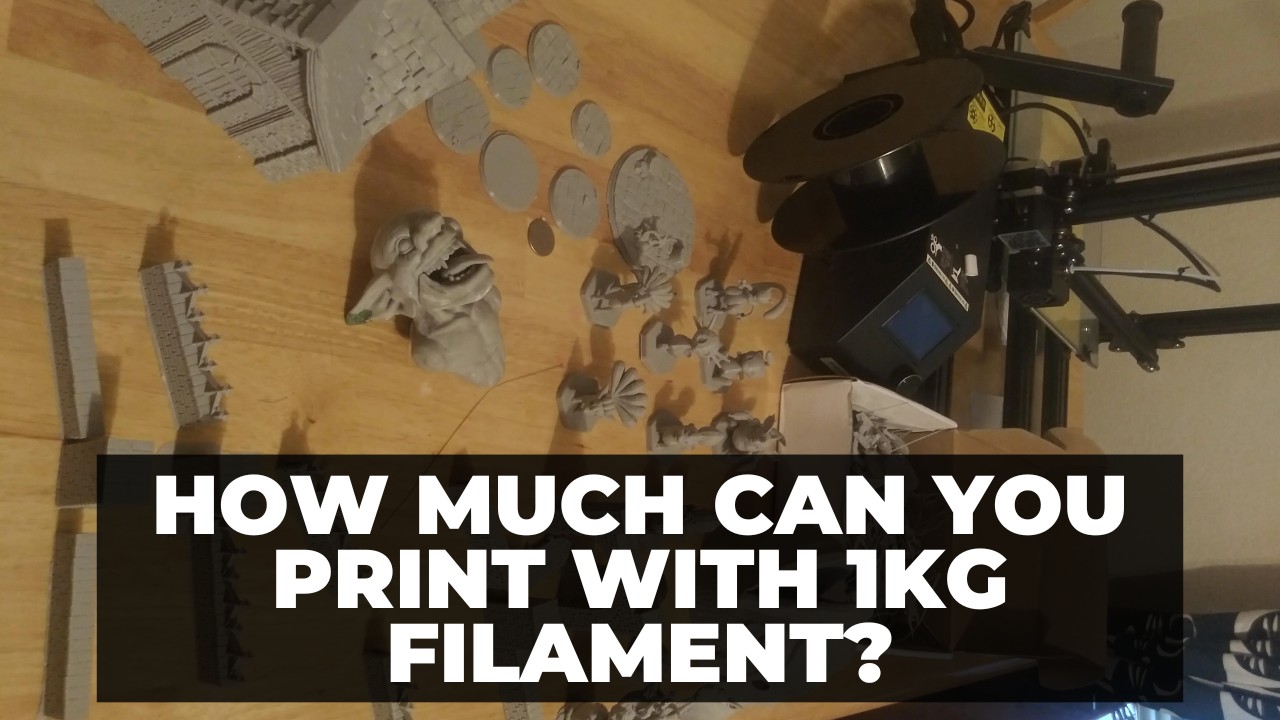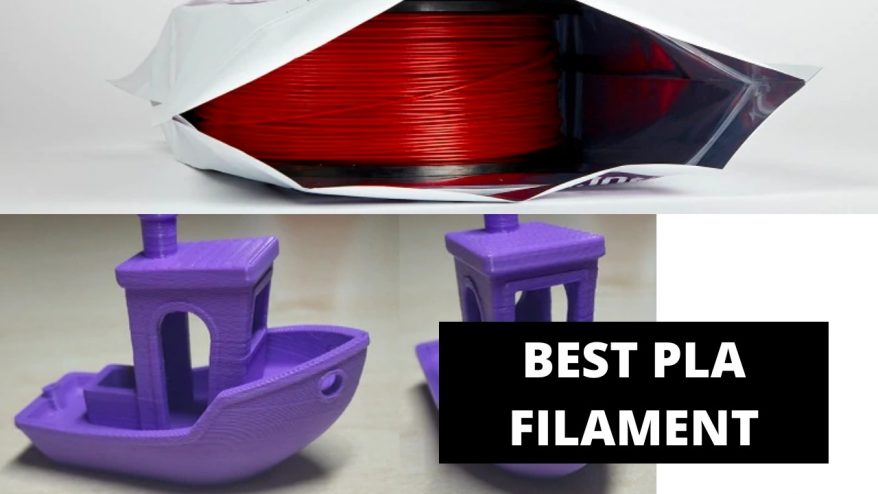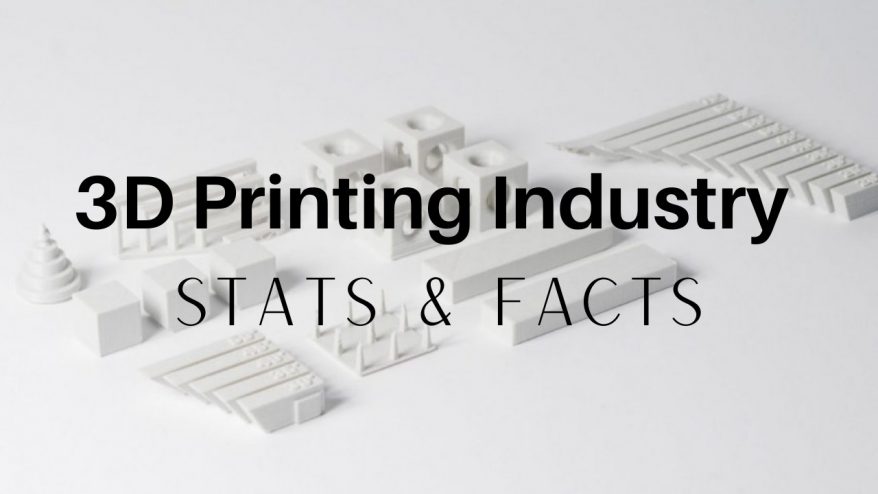PLA is very probably the most popular 3D printing filament around. There’s a good reason for that popularity. It’s one of the easiest materials to work and print with, giving good results within a wider range of variables than the majority of other filaments on the market.
PLA is versatile, relatively cheap, and very forgiving. I find it super easy to drill or cut, with very little risk of warping to my 3D prints.
But on the other hand, it’s not food safe, and you’ll need to sand it if you want that smooth finish (vapor finishing doesn’t work with PLA).
In this article, we’re going to take a closer look at all the pros and cons I’ve found from using PLA hundreds of times and show you the settings and methods I use to get the best results possible from my prints.

The Ultimate Guide to 3D Printing PLA
- The Ultimate Guide to 3D Printing PLA
- What is PLA Filament?
- What are the Best Applications for Using PLA?
- Why Print with PLA?
- Best Settings for 3D Printing with PLA
- How To Store PLA
- Making PLA filament
- Is PLA Biodegradable? And is PLA recyclable?
- A Short History of PLA in 3D printing
- Types of PLA Filament
- Drawbacks with using PLA Filament
What is PLA Filament?
You might be wondering what exactly is PLA filament made from? Well, its full term is Poly-Lactic Acid and it is a thermoplastic polymer.
Because it is derived from natural sources like corn and sometimes sugarcane, PLA is sometimes referred to a bioplastic. The majority of other thermoplastics are distilled from non-renewable resources like petroleum.
In addition, because it is a natural product, it is also long-term biodegradable. This means that when discarded into a composting system, PLA will naturally break down into its constituent parts typically within a few years.
Compare this to other thermoplastics which would thousands of years to degrade.
What are the Best Applications for Using PLA?
As PLA is so versatile, it’s a great starting filament to use for the majority of 3D prints. Be wary though, due to it being commonplace in the market – there is a lot of poor-quality PLA around. People try this, get frustrated that it’s weak and brittle, and move on to other materials to 3D print.
PLA is often used by makers and fans to create miniatures, of any particular style that they are die-hard fans of. Custom DnD characters, classic memorabilia models such as WW2 planes or retro 3D printed cars are commonly made from PLA. Cosplay props are another common application that work great with PLA, as well as general decorations.
Our advice is to use high-quality PLA. Don’t just write it off as being not strong enough for the variety of prints. You’ll be amazed at the difference. There’s no need to move onto ‘stronger’ filaments like ABS, PETG, or others until your prints get more advanced.
Typically print with PLA until you find you have a reason to experiment with other materials. When you want to print more exciting/usable products you can experiment with flexible materials.
PLA is also used in rapid prototyping, to create low-cost, accurate parts with a good surface finish. Though not terrifically strong, PLA is great for aesthetic testing for shape or size.
Why Print with PLA?
Here’s why we love PLA 3D printer filament so much:
- Easy and forgiving to print — get good quality PLA and it’ll flow nicely and won’t warp, making it safe for kids to 3D print.
- Finish detail — usually very neat. It isn’t prone to stringing or blobbing.
- Post print finishing is straightforward — it’s easy to sand, drill, or cut after printing.
- It can be surprisingly strong.
- PLA can be pigmented easily — so you’ll usually find color selections better and more vivid.
- It doesn’t smell bad when printing (not that you should be smelling it, always print in well-ventilated areas).
- Biodegradeable — you don’t need to feel bad throwing it out, because eventually, it’ll biodegrade. It also has non-toxic and all-natural ingredients. PLA comes from a renewable resource, usually from corn, and under industrial composting conditions will degrade.
- PLA print temperature is lower than most other filaments.
- No harmful fumes when printing — whereas filaments like ABS can create smelly fumes that may be harmful, PLA is safe and odorless, as it is formed from crops rather than petroleum-based compounds.
- Cheap — PLA is one of the cheapest filaments around, and for the price, offers a good surface finish and part strength.

What’s the difference between ABS and PLA?
While for the majority of prints, good quality PLA is strong and a great all-rounder, it’s worth understanding what ABS filament can be used for too.
Here are the key differences between the two summed up:
- ABS is a little more durable than PLA, and slightly stronger – it’s also less dense. This does make ABS a great upgrade material for some end-use parts if for some reason PLA won’t quite cut it.
- ABS smells stronger (like melting plastic) when printing. While ABS and PLA both give off fumes when printing (so ALWAYS print in well-ventilated areas) but PLA smells much softer and slightly sweet.
- ABS can be acetone smoothed, which is a way to smooth out the layer lines left by 3D printing. It can also increase the ultimate strength of your print.
- While PLA is long-term biodegradable, ABS isn’t. However, ABS is recyclable. Note: To ensure it can be recycled just make sure you print the #9 Recycling logo on each print.
Read more: PLA vs ABS

Is PLA filament food safe?
When not 3D printed, yes. If you’re new to 3d printing, it’s likely that you’ve already encountered PLA around your home.
PLA is used to make many common objects, including food containers, disposable tableware and garbage bags.
However, 3D printing in PLA will not create food-safe containers, because 3d printing can cause many tiny gaps and cavities in your prints that will harbor moisture and food residue.
After a few washes, this will turn into mold and you won’t be able to keep it clean.
Even though PLA is biodegradable it is still a strong and durable material. You will find PLA to be harder than other common thermoplastics like ABS.
However, its lower tensile strength tends to make it more brittle PLA.
What is PLA melting point?
It should be noted that PLA melting temp is relatively low temperature, in the neighborhood of 170°C upwards which makes it a poorer choice for objects that will be used in a higher temperature application.
Objects that are 3D printed with PLA will hold up fine when used at room temperatures in a normal environment.
Can you paint on PLA filament?
Yes, it’s easy to paint your PLA prints. It’s best to use acrylic-based paints, but you can also use oil or cellulose spray paints. We recommend using kid-friendly paints if safety is a concern.
Check out our guide on getting a professional-grade finish with your prints.
Best Settings for 3D Printing with PLA
Now that you know what PLA is and you have a general understanding of its strengths and weaknesses, let’s take a look at some of the things that you can do to get the most out of using PLA as a print material.
In this regard, we’re going to look at three critical areas that can affect the success of any 3D printing job – temperature, adhesion, and material storage.
In any print job, it’s very important that you get the printing temperature just right if you want a good run. Printing with PLA is no exception to this rule.
It’s worth noting that higher-quality PLAs print at lower temperatures, due to the purity of the resin and lack of contaminants.
PLA benefits from relatively low shrinkage, hence the low-to-no warp. While the PLA shrinkage varies from manufacturer to manufacturer, it is usually within the 2-5% range.
You’re best printing a model that’s a known length, with both horizontal, vertical, and perpendicular holes in that you can measure its length, and dimensions of the holes after printing to compare.
What Temperature is Best for Printing PLA?
In general, PLA filament settings have an optimal printing PLA temperature range from about 185°C to about 205°C. If you’re using 1.75mm as opposed to thicker 2.85mm (or 3.00mm) your optimal print will be closer to the lower end of this PLA filament temperature range.
If you’re using 2.85mm filament, you might want to go closer to the higher end of the temperature range to compensate for the increased thickness of the material.
With any material, and PLA extruder temperature can differ (+/-10%) depending on your machine. It may be wise to independently measure the temp of your extruder nozzle to accurately dial in the extrusion heat.
- PLA density: around 1.24 g/cm³ (changes if blended with other materials or filaments)
- PLA glass transition temperature: 60-65°C

In any event, no matter what PLA filament temperature you start with, you do want to adjust that temperature slightly upwards or downwards depending on the environment of the room you are printing in and the initial print conditions that you observe.
In general, it’s a good idea to start PLA printing temperature at about 180°C and note how the material is being extruded, as well as the quality of the print layers being produced.
That’s usually the best temp for PLA settings. If you note problems with the material, simply adjust the temperature up or down in 5°C increments until the problem is no longer noticeable.
Please note that due to the high quality of our PLA you’ll want to typically print at lower temperatures than others available.
Finding the best PLA temperature can be a little trial and error but is nearly always nearer the lower end of the spectrum for higher-end filaments.
Your print temperature is probably too high if you notice that strings of material are occurring as your printer is moving between different parts of the print job.
This “stringing” happens because the PLA loses too much viscosity due to being too hot. As a result, the material leaks out of the print nozzle as it moves.
If this happens for you after reducing your hot-end temperature, increase retraction distance slightly and definitely increase cooling. For more information with printing faults, check out our Ultimate 3D Print Quality Troubleshooting Guide here.
Your print temperature is probably too low if you notice that the PLA is having trouble adhering to the print surface or to previous layers. Temperature is also likely the cause of problems in the surface of the printed object like gaps, holes and missing layers.
However it’s worth noting in our experience, 90% of problems printing with PLA is that it’s simply being printed too hot. So if in doubt on your 3D printer settings for PLA, turn it down.
This is an indication that the PLA is under extruding because of a higher material viscosity caused by a PLA 3D printing temperature that is too low.
In either case, dialing in the correct print temperature will increase the chances that you’ll end up with an object that is both useful and beautiful.
Be careful you don’t boil your PLA. This sounds odd, but it’s easy to print good quality PLA too hot.
If you’re doing high detail or bridges, you want to control your PLA print temp with fans, to prevent sagging or loss of detail to ‘melting’ style effects.
PLA Print Speed
When it comes to print speed, every printer is different and optimum settings will depend on what type of printer you’re using.
Generally, printing PLA is usually good at any speed between 30mm to 90mm/sec. For higher-quality end results, a lower printer speed is more likely to get you the finished product that you want.
As with temperature, the best speed for the object that you’re printing will need to be dialed in.
Adhesion

Getting your print material to adhere to your print surface is key to a successful print run. One of the things that make high-quality PLA one of the easier materials to print with is that it somewhat easily adheres to a wide variety of surfaces with a minimum of fuss.
Printing PLA without a heated bed is easily done – although to aid first layer adhesion we do recommend a heated bed between 40-50°C.
Problems with your PLA filament not sticking? Take a look at our article on build plate surfaces and adhesion to get an idea of what PLA build surfaces might work best for you.
One additional thing should be noted. PLA doesn’t require a heated bed to print it as it’s low warp, but you might want to use one as it can make those first few layers of adhesion easier.
If your PLA does warp, you might want to take a look at our article “Warping – Why It Happens and How to Prevent It” which can be found here.
How To Store PLA

PLA, like a number of other thermoplastics, is hygroscopic. This means that, over time, it naturally absorbs water from the air that surrounds it. When water builds up it PLA, it tends to break down or alter the molecular chains that hold the PLA together.
When you print with PLA that has absorbed water, you will find that it is harder to get layers to bind together and those that do bind together tend to be distorted.
Is your PLA filament brittle or snapping? That’s likely caused by (assuming it was good filament to start with) it having absorbed moisture.
The solution to this problem is in proper storage of your PLA when you’re not printing.
Ideally, to maintain optimum printing conditions with your PLA, you should store it in an airtight filament container. We have linked to some we recommend below.

Low cost filament seems like a bargain, but it’s not. Yes, you don’t pay as much upfront for your printing material. However, when design after design is ruined because of imperfections in the filament, the cost of buying replacement filament begins to add up.
Making PLA filament
PLA is made by adding enzymes to starch harvested from crops such as corn to convert it into dextrose. Any pigments are added based on what color filament you want, as well as any blends for any hybrid type of PLA.
The mixture is fermented into lactic, which is then turned into polylactide. The process to get it to become a plastic on a spool involves drying the mixture out, putting into an extruder and heating, to be extruded into solid filament.
The filament is then cooled and wound onto a circular spool so that it is then ready to print.
Is PLA Biodegradable? And is PLA recyclable?
Many highlight the environmental benefit when arguing for the use of PLA in 3D printing and beyond, as it comes from a renewable resource rather than petroleum-based materials.
This is true, maize and other crops are renewable. However, we must also account for the opportunity cost of those crops being used to feed people – it is not such a cut-and-dried issue.
While undoubtedly avoiding non-renewables that pollute is positive, it takes between 2 and 3kg of corn to create 1kg of PLA. To completely replace non-renewable plastic production would take food from hundreds of thousands of people’s mouths. With demand for these crops exploding as the population continues to increase, this becomes less and less feasible.
Additionally, while PLA is biodegradable, this is under conditions of high 55-70°C temperatures. In normal day-to-day temperatures, it could take 80 years to decompose.
As for recyclability, yes, PLA is recyclable if collected especially for PLA. If contaminated with other plastics like PET this affects recyclability, resulting in large amounts of PLA not being recycled simply because systems are not in place to specifically recycle PLA.
A Short History of PLA in 3D printing
Polylactic Acid, shortened to PLA, was first used for 3D printing by Vik Olliver, one of the first champions of the RepRap movement. Struggling to find a good material for their first RepRap 3D printers to use, Vik Olliver collaborated with a New Zealand-based plastic manufacturer to get the first PLA filament made. It proved effective, and now 15 years later PLA is the most widely used filament in the world.
This is discussed in more detail in our long-form interview with Dr Adrian Bowyer MBE, the founder of the RepRap movement.
PLA is also one of many filaments compatible with the Ender 3, which is the most popular 3D printer out there – helping to bring the material to the masses.

Types of PLA Filament
There are actually even more than the ones listed here. These are some commonly seen variants:
- PLA+: an improved version of PLA blended with other plastics. It is known for being less brittle – a major drawback of PLA – and absorbs less moisture, as well as offering better mechanical properties.
- Wood-filled: printed parts look wooden
- Metal-filled: gives parts a realistic metallic look. Mixes include stainless steel blends, aluminium, copper, brass and bronze PLA filaments.
- Carbon fiber infused: for very strong, lightweight parts
- Flexible PLA: mixed with TPU or similar
- Aesthetically modified PLA: including glow-in-the-dark PLA, transparent or translucent blends, silk-like PLA, glittery and sparkly PLA, fluorescent, and color-changing PLA based on factors such as heat or UV light.
- Conductive PLA
- Lightweight (LW-PLA): designed so it foams when melts, spreading to a larger surface area to print lighter parts that require less filament to print. It’s more expensive, but allows for up to 65% lighter parts that print quicker.
Read more: best PLA filament
Drawbacks with using PLA Filament

- Brittle: not suitable for prints that need to be malleable or twisted in any way. Some PLA+ filaments somewhat improve the brittleness issue, but for these parts TPU or other more versatile filaments are better suited.
- Problems with oozing: need to set up an effective cooling fan system and retraction settings to counteract this.
- Not ideal for durable parts: has a glass transition temperature of between 60-65C, so PLA is not suitable for parts to be used outside or in hot temperatures. Moreover, filaments like PETG and ABS have stronger mechanical properties, so are better for functional parts.
- Not food safe: despite PLA being used with food packaging, PLA filament is not food safe. There are however food safe variants for applications where this is important.

















